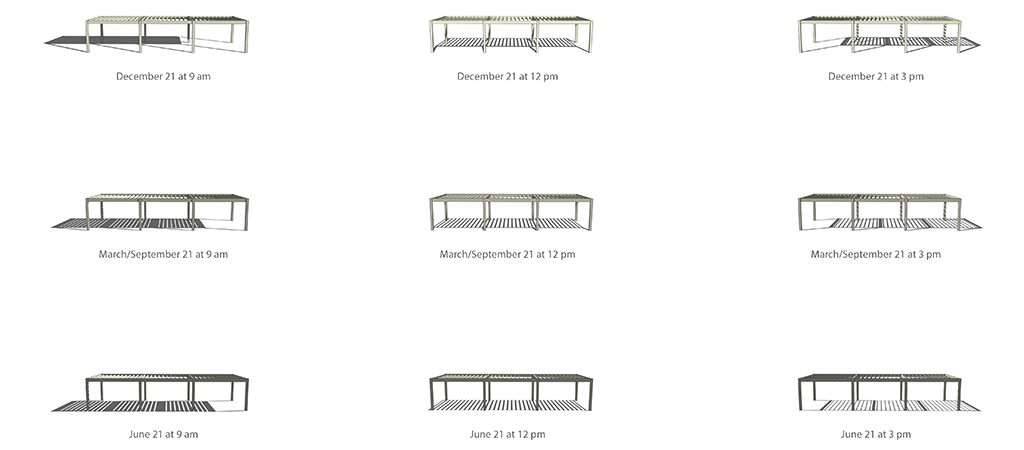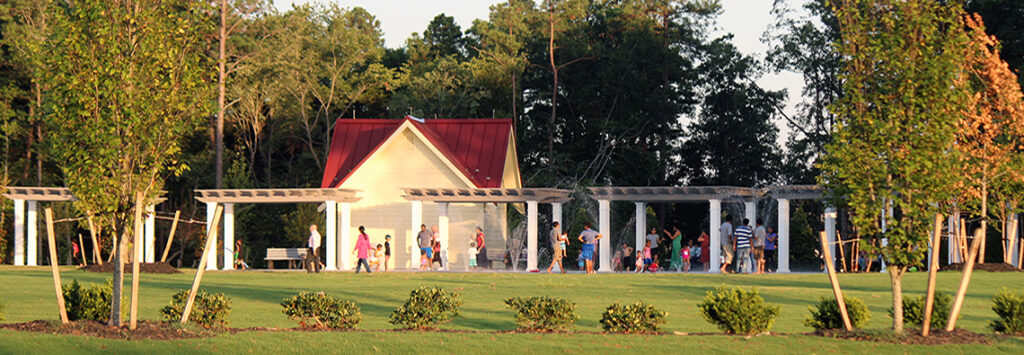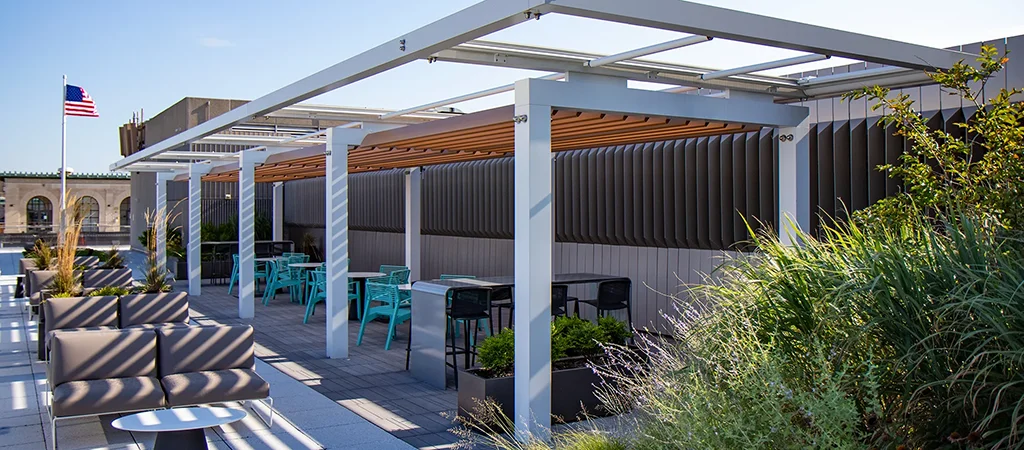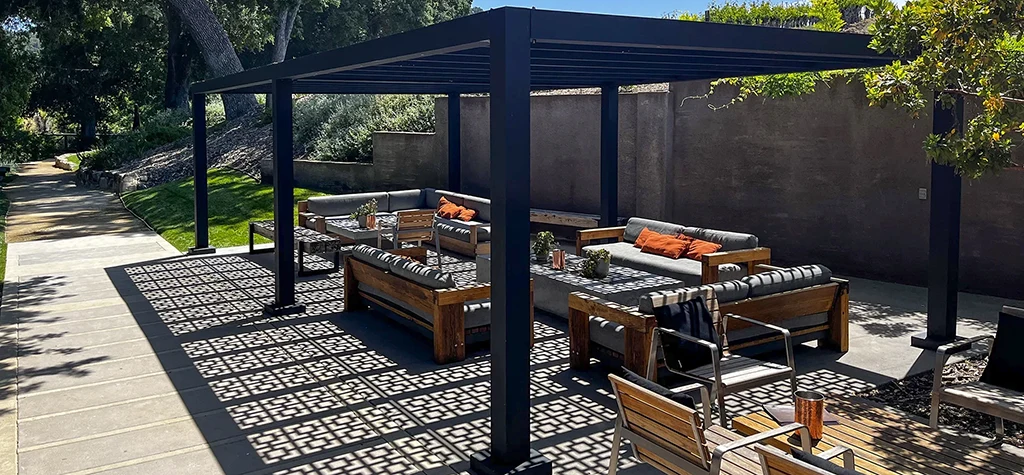Did you know that effective shading can reduce surrounding temperatures by up to 20 degrees?
As a design professional, you have the super power to transform outdoor spaces into comfortable, sustainable spaces that enhance personal well-being. One of the most impactful tools at your disposal is a shade study—a vital step in designing pergolas and shade structures that truly benefits people and the surrounding environment.
How a Shade Study can Enhance Well-Being
Improved Comfort
Let’s face it: nobody enjoys sweltering under the blazing sun. By conducting a shade study, you can pinpoint exactly where and when shade is needed most. This ensures that outdoor spaces remain comfortable throughout the day, encouraging people to use and enjoy them more frequently.
- Design Tip: Analyze the sun’s path to optimize the placement and orientation of your pergola or shade structure, thus maximizing comfort during peak usage times.
Health and Well-Being
Excessive sun exposure isn’t just uncomfortable—it can be harmful. Prolonged exposure to UV rays increases the risk of skin cancer and other health issues. Shade structures designed with precise shade studies offer protection, making outdoor areas safer for everyone.
- Design Tip: Be sure to incorporate materials with high UV protection ratings in your design to enhance the health benefits for users. These materials include HDPE and canvas canopies, aluminum screen panels or polycarbonate roofing panels.
Environmental Benefits
Shade structures do more than protect people; they also contribute to environmental sustainability. By reducing the heat island effect in urban areas, they help lower ambient temperatures and reduce energy consumption in nearby buildings.
- Design Tip: Use sustainable materials and consider vegetative elements like green roofs or climbing plants to enhance environmental benefits. Be sure to select plant varieties that are less likely to cause any damage to the structure.
How to Effectively Conduct a Shade Study

Step 1: Understand the Site
Before anything else, get to know the installation site intimately. Collect data on geographic location, climate patterns, and existing buildings or vegetation that may affect sunlight and shade. Modeling these along with your structure will give you better insight to the overall project.
Step 2: Utilize the Right Tools
Todays software makes a shade study easier and more precise than ever. Tools that you can use include:
SketchUp with Shadow Analysis Plugin: Great for quick visualizations.
Autodesk Revit: For comprehensive 3D modeling and solar studies.
Rhino with Grasshopper: Ideal for parametric design and complex calculations.
Step 3: Analyze Sun Paths
Understanding the sun’s movement is crucial for accurate shading. Understanding the movement of the sun relative to your project site allows you to design shade structures that provide optimal comfort, enhance energy efficiency, and contribute to the well-being of users.
Step 4: Design and Adjust Structures Accordingly
Let the data guide your design decisions. Modify the orientation, height, and elements of your pergola or shade structure based on your findings to maximize shade effectiveness.
Making A Difference
Laidback Winery Patio
A California winery wanted to make its patio more inviting during hot afternoons.
- Solution: Conducted a shade study that revealed the effectiveness of shade panels on an aluminum pergola.
- Result: Increased patronage by 35%, as customers enjoyed the comfortable outdoor seating.
Community Park Enhancement

A Virginia city park had low daytime visitation due to lack of shade.
- Solution: Implemented seven fiberglass shade structures based on a comprehensive shade study.
- Result: Park usage increased, and the local community reported higher satisfaction.
Eco-Friendly Office Space

An office building in DC aimed to create a rooftop outdoor workspace that was both comfortable and sustainable.
- Solution: Used shade studies to design a pergola that incorporated fixed louvers and motorized canopies.
- Result: Improved employee well-being and created a great outdoor workspace.
Sustainability: A Core Pillar in Shade Design
Material Selection
Choosing sustainable materials enhances both environmental impact and aesthetic appeal.
- Design Tip: Opt for recycled metals, sustainably sourced wood, or innovative composites in your designs. Aluminum is “infinitely recyclable” and nearly 75% of all aluminum ever produced is still in use today
Energy Efficiency
Shade structures can significantly reduce energy consumption by lowering cooling needs in adjacent buildings.
- Design Tip: Position shade structures to block excessive sunlight from windows and doors, reducing indoor temperatures naturally.
Green Integration
Incorporating plants and greenery can amplify environmental benefits.
- Design Tip: Design pergolas to support climbing plants or integrate green roofs improving air quality and biodiversity. For a lightweight sedum roof that loves the sun, the structure needs to be able to support at least 225 lb per square yard at 6″ depth. A wildflower roof needs more growing medium and can weigh in excess of 450lb per square yard at a depth of 6″.
The Power of Customer Collaboration
Working closely with clients not only meets their needs but often exceeds their expectations. Incorporating customer feedback can lead to more effective, customized designs that stand out in the market while building a strong client relationship that can enhance your reputation and open doors to new opportunities.
- Design Tip: Involve clients in the shade study process. Use visual aids and simulations to illustrate how your design choices will benefit them and the end-users.
Benefits of Collaboration
- Enhanced Satisfaction: Clients feel valued and are more likely to be pleased with the final outcome.
- Better Insights: Clients can provide user-specific information that can be crucial for a final design.
- Stronger Relationships: Collaborative projects build trust and open doors for future partnerships with both clients and manufacturing.
Transforming Outdoor Spaces Together
Conducting a shade study is an indispensable step in designing pergolas and shade structures that truly enhance human well-being. By focusing on comfort, health, and environmental sustainability, you can create outdoor spaces that people love and actively use.
Are you ready to make a lasting impact with your next outdoor project?
Collaborate with Structureworks to design shade structures that are not only beautiful but also enrich lives and respect the environment.
